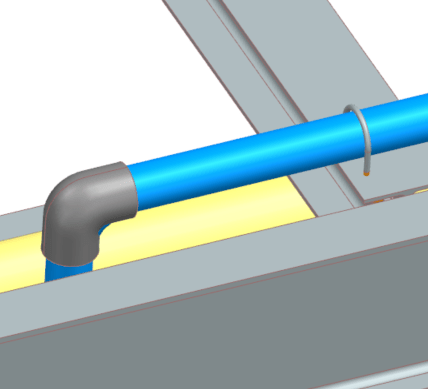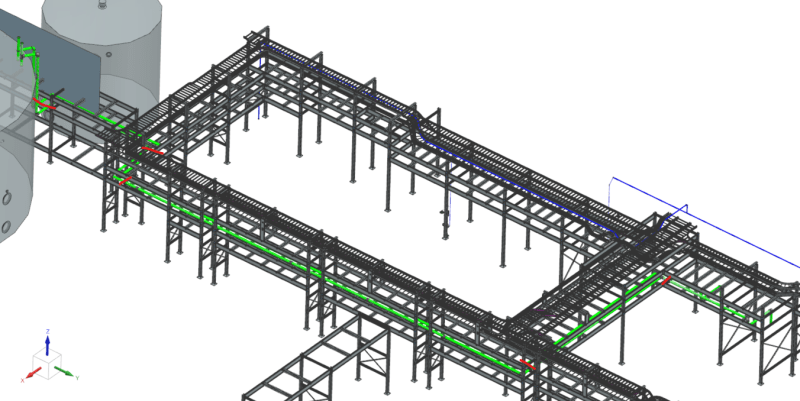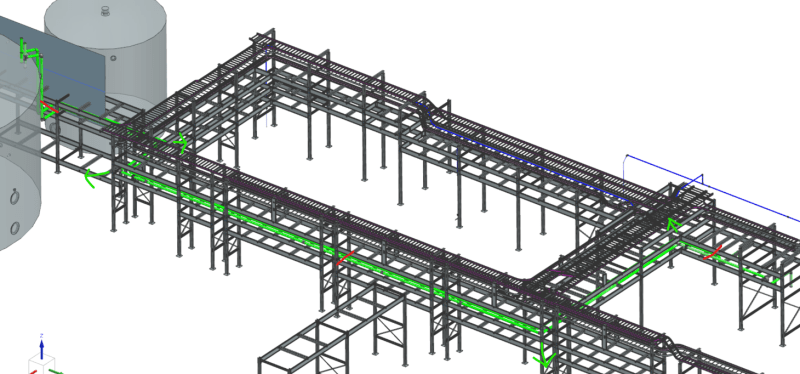NW_Wash_Eng
Mechanical
thread164-494356
Good morning all,
I have been tasked with figuring out where to install thrust bracing on 90deg elbows for an open pipe system. These are going to be a mix of SCH10 SS and SCH80 PVC pipes, varying anywhere from 1" to 12" in diameter. My thought process here, and please correct me if I am wrong, is to calculate the static pressure force and sum it with the dynamic force that the fluid flow will be causing. I believe an example might be the most efficient way for me to go through this;
System knowns:
Pipe size: 12" SCH10 304SS
Fluid Flowrate: 2600GPM
Gauge Pressure: 10PSI
Assume fluid is water or comparable
Using the info above, I get a cross sectional area of roughly .837ft^2 at a velocity of 6.919ft/sec
Static Pressure Force=gauge pressure*144*cross section of pipe
= 10psi*144*.837ft^2
=1206lbf
For Dynamic force, I referenced this:
more specifically, this: R=ρAv^2(1-cosβ)
Dynamic Force=R
=(density of water/gravity)*cross section of pipe*velocity^2*(1-cos(angle of elbow))
=(62.4/32.2)*.837*6.919^2*(1-COS(90))
=112.47lbf
Summing these two, I get 1318lbf.
My main question here is, what do I compare this to in order to understand what is "too much" or going to become a problem over time? We plan to secure the pipes to our racks with standard u bolts. To prevent crevice corrosion on the SS pipes, we are adding strips of UHMW between the pipes and the racks. I am worried we will not be able to tighten the u bolts enough to hold the pipes down fully on that UHMW. I am also worried we would crack the PVC before we got to a point where we could react these summed forces correctly.
Is there a rule of thumb that is something like "1500lbf or greater on pipes sized X through Y needs thrust blocking?"
Good morning all,
I have been tasked with figuring out where to install thrust bracing on 90deg elbows for an open pipe system. These are going to be a mix of SCH10 SS and SCH80 PVC pipes, varying anywhere from 1" to 12" in diameter. My thought process here, and please correct me if I am wrong, is to calculate the static pressure force and sum it with the dynamic force that the fluid flow will be causing. I believe an example might be the most efficient way for me to go through this;
System knowns:
Pipe size: 12" SCH10 304SS
Fluid Flowrate: 2600GPM
Gauge Pressure: 10PSI
Assume fluid is water or comparable
Using the info above, I get a cross sectional area of roughly .837ft^2 at a velocity of 6.919ft/sec
Static Pressure Force=gauge pressure*144*cross section of pipe
= 10psi*144*.837ft^2
=1206lbf
With the *144 being a unit conversion
For Dynamic force, I referenced this:
more specifically, this: R=ρAv^2(1-cosβ)
Dynamic Force=R
=(density of water/gravity)*cross section of pipe*velocity^2*(1-cos(angle of elbow))
=(62.4/32.2)*.837*6.919^2*(1-COS(90))
=112.47lbf
For my own notes, dividing by gravity to get units into lbf from lbm
Summing these two, I get 1318lbf.
My main question here is, what do I compare this to in order to understand what is "too much" or going to become a problem over time? We plan to secure the pipes to our racks with standard u bolts. To prevent crevice corrosion on the SS pipes, we are adding strips of UHMW between the pipes and the racks. I am worried we will not be able to tighten the u bolts enough to hold the pipes down fully on that UHMW. I am also worried we would crack the PVC before we got to a point where we could react these summed forces correctly.
Is there a rule of thumb that is something like "1500lbf or greater on pipes sized X through Y needs thrust blocking?"




